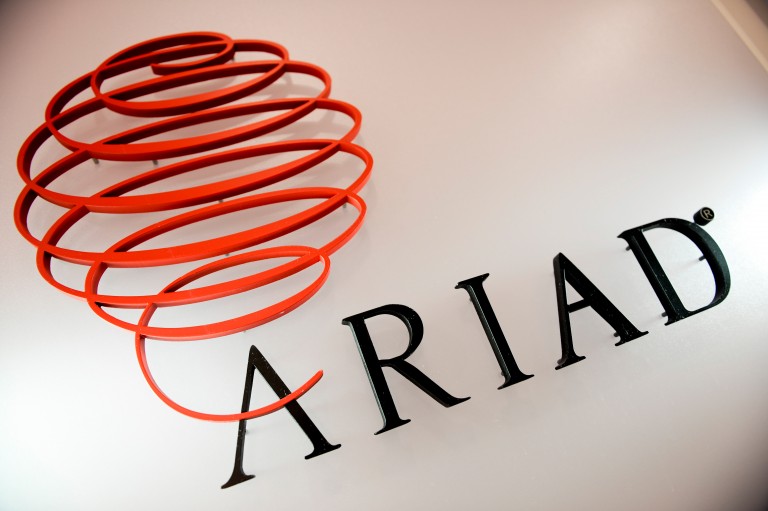
Of all the medium cap biotechs that have had drug approvals at some point across the last half decade, Massachusetts based Ariad Pharmaceuticals, Inc. (NASDAQ:ARIA) has had one of the toughest rides. Back in 2012, the company gained to trade just ahead of $25 a share on the back of the FDA approving its chronic myeloid leukemia drug, Iclusig. Less than twelve months later, however, in September of 2013, the agency temporarily suspended its approval, citing concerns of fatal blood clots in a subpopulation of patients. Ariad shares fell from a little over $20 to $2.67 overnight, and bottomed out a couple of days later at $2.32 – a 90% decline on the company’s 2012 market capitalization high. The issue resolved, but not without a pretty stern boxed warning, and Ariad has limped along ever since. A combination of high R&D costs, high operational expenses and the limitations of a boxed warning on potential Iclusig sales has hindered any real recovery, and 2012 shareholders who have held their position remain 75% down on their initial exposure.
Click Here For More Market Exclusive Updates & Analysis
With a number of recent announcements, however, Ariad looks like it might finally be turning around. If so, it might make an attractive allocation ahead of a recovery, be it operationally driven, via the successful commercialization of its follow up to Iclusig, or a combination of the two. Here’s how things could play out.
First, let’s touch on the operational side of the equation. The company announced the hiring of a new CEO Paris Panayiotopoulos at the end of last year, and he took charge January 1, 2016. He’s a prior Eli Lilly and Co (NYSE:LLY) and Merck & Co., Inc. (NYSE:MRK) exec, and his primary remit looked set to be the reaching of a black bottom line. With a new CFO hire reported in March, and subsequent workforce trimming to the tune of 25% (with none coming from front line sales), he looks to be well on the way to achieving this remit. In all likelihood, staff cuts and the ramping up of Iclusig sales (target is $190 million during 2016) won’t get him there though. He’ll also need another drug to hit markets – and that’s where the second element of the Ariad turnaround comes in to play.
On Monday, April 11, the company announced the initiation of a pivotal trial in its now lead development candidate, and the follow up to Iclusig, Brigatinib. The drug is a first line candidate with an ALK-positive non small cell lung cancer (NSCLC) indication, which picked up breakthrough designation back in October 2014. This is the latest expansion of an ongoing development profile for Brigatinib – it’s also currently in a phase II in patients with NSCLC that have already received an ALK inhibitor (in this instance, crizotinib). If both trials run smoothly, we could see an NDA submission based on the latter mentioned phase II before the end of 2016, and a follow up NDA based on data from the former, the just announced ALTA phase III, early 2018.
ALK inhibitors are a relatively new wave of oncology drugs, which work through the inhibition of what’s called anaplastic lymphoma kinase (ALK) – an enzyme produced from a gene called the ALK gene, which is known to be responsible for certain fusions to other genes, and in turn, oncogenic cell production. There are two currently approved – the aforementioned crizotinib, which Pfizer Inc. (NYSE:PFE) markets as Xalkori, and Alectinib, which is marketed in Japan by Chugai, a subsidiary of Hoffmann-La Roche.
Xalkori generated just shy of $500 million revenues for Pfizer during full year 2015, so if Ariad can demonstrate a stat sig improvement, or even equivalency, in efficacy with the just kicked off phase III, the company cold be set to compete to what’s expected to be a billion dollar market by the end of the decade.
To summarize, Ariad has had some modest success with its oncology drug Iclusig, but boxed warnings, adverse events, and overspending in the R&D department has meant the company has struggled to generate a net income over the last few years. This has impacted both its market capitalization and its cash position, which currently came in at $230 million at last count (end December, 2015). With cost cutting, the advancing of its lead development candidate into two pivotals, and the potential for one NDA before the year is out and a second to follow not long after, however, this could soon change. For current holders looking to recoup some of the hit taken on the 2014 decline, this could be a turnaround point. For those without an allocation, the company looks cheap given current factor and conditions. One to watch.




